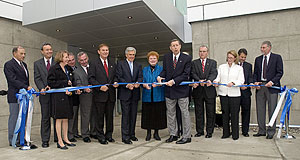Campus News
Opening of Gen*NY*Sis Center
by Carol Olechowski (November 22, 2005)
 |
President Kermit L. Hall and group in a symbolic ribbon-cutting for the new UAlbany facility. |
Officially, it's known as the University at Albany's Gen*NY*Sis Center for Excellence in Cancer Genomics. But for the researchers located there; the state legislators who saw a need for it; and the individuals, foundations, and corporations pledging their financial support, the $45 million East Campus structure is actually a place of hope where a cure for cancer may be discovered.
At the Oct. 18 opening ceremony, University President Kermit L. Hall called the center "a powerful symbol of hope." He also introduced the facility's scientists, who will "find better ways to fight the scourge of cancer, the leading cause of disease-related deaths in the United States. They will help realize the hope we have for the future" as the high-throughput, or high-speed, high-volume, research is eventually applied to clinical trials and patient care, then "translated into treatment."
Hall credited New York State Senate Majority Leader Joseph L. Bruno with pointing out in 1995 that "the state and its research universities needed to focus more on biotechnology and research for the good of the citizens and the growth of the economy." Bruno's call led to the establishment of the Generating Employment Through New York Science (Gen*NY*Sis) program, a $500 million government-private sector partnership. UAlbany's center, the president added, is the program's "cornerstone."
"What we have is a team of movers and shakers, supporters, scientists," Bruno noted, recognizing the University and his fellow lawmakers for making the Gen*NY*Sis Center a reality. "When you put together support such as exists here at the University, in the private sector and in government with people who have creativity and enthusiasm, you do great and wonderful things. One hundred people a day in New York die of cancer. What's happening here is critically important," added the senator, himself a cancer survivor.
Mary Polsinello Hanley's life has also been touched by the disease. She recalled seeing a newspaper article about the proposed Gen*NY*Sis Center shortly after her son, James, passed away from brain cancer in 2002. "I called [Center Director] Paulette McCormick, who invited me to see her. Paulette took her time and explained to me everything about my son's illness and what could have been done. I came away with a good feeling and told her I wanted to be as active [in this project] as I could. I don't have many years, but what Paulette has done inspired me and gave me strength to watch this building go up. I call it 'the building of love and hope.' I would ride by here when I was doing my errands, and I would say, 'This is my building.' Paulette said this is where we will find the cure. I hope the staff and scientists will."
Hanley was the first donor to the Wall of Memory and Hope, which adorns the atrium of the building. Her gift memorialized her son.
In her remarks, McCormick read the names inscribed on the wall, then thanked the center's faculty and staff. She concluded: "This building is meant to embody and realize hope. Hope is the best antidote for grief, and it's the very last thing that we can afford to lose."
The ceremony was followed by a ribbon cutting and tours of the 116,338-square-foot Gen*NY*Sis Center. On the first floor, near the Wall of Memory and Hope, is a seminar room that accommodates up to 75 people and can be converted to use by small cancer support groups or by larger groups for presentations. A kiosk in the lobby allows those wishing to memorialize family members or friends who have suffered from cancer to make donations; a contribution of $100 will add a name to an electronic listing for at least one year. All donations support the center's work.
Research laboratories are on the second
and third floors. The Walter and Anne Robb
Imaging and Histology Laboratory, named for
the couple who made a $200,000 challenge
grant to the Wall of Memory and Hope, is
also located on the third floor, as is the
Troy Savings Bank Charitable Foundation Board
Room.
